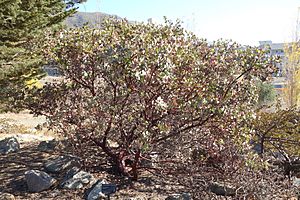Bishop manzanita facts for kids
Quick facts for kids Bishop manzanita |
|
|---|---|
 |
|
| Scientific classification | |
| Kingdom: | |
| (unranked): | |
| (unranked): | |
| (unranked): | |
| Order: | |
| Family: | |
| Genus: | |
| Species: |
A. obispoensis
|
| Binomial name | |
| Arctostaphylos obispoensis |
|
Arctostaphylos obispoensis is a special type of plant called a manzanita. People also call it the bishop manzanita or serpentine manzanita. This plant is found only in California, which means it's endemic there.
Contents
Where the Bishop Manzanita Lives
This unique plant grows only in the southern part of the Santa Lucia Mountains in California. You can mostly find it in San Luis Obispo County. It also grows a bit into southern Monterey County.
Its Favorite Places to Grow
The bishop manzanita likes to live in certain types of natural areas. These include chaparral (a type of shrubland) and closed-cone pine forests. It often grows in a special kind of ground called serpentine soil. This soil is rich in certain minerals.
You can find these plants at different heights, from about 60 to 950 meters (200 to 3,100 feet) above sea level.
Protecting This Special Plant
The bishop manzanita is protected in a special area called the Cuesta Ridge Botanical Special Interest Area. This area is part of the Los Padres National Forest. Here, it grows alongside the Sargent cypress, another unique plant.
The California Native Plant Society lists this manzanita as a rare plant. However, it is not currently considered endangered, which means it's not in immediate danger of disappearing.
What the Bishop Manzanita Looks Like
The Arctostaphylos obispoensis is a sturdy plant. It can be an upright shrub or a tree with many trunks. It usually grows to be about 1 to 4 meters (3 to 13 feet) tall.
Leaves and Branches
Its smaller branches and new leaves feel soft and woolly. The older, mature leaves are a grayish-blue color and are smooth, without hairs. They are shaped like an oval or a wide spear, and can be up to 4.5 centimeters (about 1.8 inches) long.
Flowers and Fruit
The flowers of the bishop manzanita grow in tight bunches. They are white and shaped like small urns, hanging downwards. These are typical "manzanita" flowers.
After the flowers, the plant produces red, round fruits. These fruits are waxy and are a type of drupe, similar to a cherry or plum. They are about 9 to 14 millimeters (0.35 to 0.55 inches) across.
See also
 In Spanish: Arctostaphylos obispoensis para niños
In Spanish: Arctostaphylos obispoensis para niños

